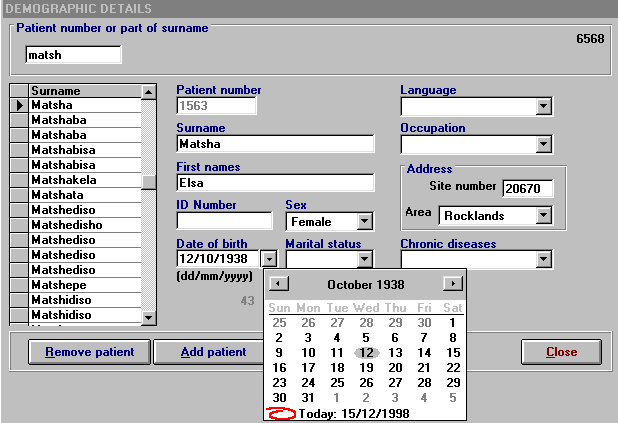Patient Registration Software: Transforming Healthcare Efficiency and Patient Experience in 2025
In today’s digital healthcare landscape, patient registration software has emerged as a critical tool for healthcare providers aiming to streamline operations, reduce administrative burdens, and enhance the overall patient experience. With increasing pressures to improve efficiency and accuracy, hospitals, clinics, and medical practices are turning to advanced software solutions that automate and optimize the patient registration process. This article explores the role, benefits, and strategic implementation of patient registration software, backed by realistic statistics and real-world case studies, to help you understand how this technology can transform your healthcare organization.
According to a study published in the Journal of Medical Internet Research, digital registration systems can reduce patient wait times by up to 30% and cut administrative costs by 20–30% compared to traditional manual methods. As healthcare institutions face mounting operational challenges, understanding what patient registration software is and how to implement it effectively is essential for staying competitive in the digital age. For healthcare organizations ready to embrace this digital revolution, partnering with a trusted technology provider is key. Savvycom, a leading software development company, delivers comprehensive, custom solutions that optimize your patient registration process and drive long-term success.
What Is Patient Registration Software?
Patient registration software is a digital platform designed to automate the process of registering patients in healthcare facilities. This software replaces manual, paper-based systems with a streamlined, user-friendly interface that collects, stores, and processes patient data efficiently. The core functionalities typically include online registration forms, appointment scheduling, electronic medical record (EMR) integration, and real-time data analytics.
By automating these processes, patient registration software not only minimizes errors and delays but also frees up administrative staff to focus on more critical tasks, ultimately improving patient care. A report by HIMSS states that hospitals utilizing digital registration tools can experience a 25% boost in operational efficiency and a significant reduction in data entry errors.
Key Features of Patient Registration Software
1. Multi-Channel Registration and Communication
One of the most significant advantages of patient registration software is its ability to integrate multiple communication channels into a single, cohesive platform. Whether through web portals, mobile applications, or in-clinic kiosks, these systems enable patients to register and update their information quickly and conveniently. For instance, a study by HealthIT.gov found that facilities employing digital registration methods saw a 30% reduction in patient check-in times, leading to enhanced satisfaction and operational throughput.
- Real-Time Notifications: Automated appointment reminders and notifications help reduce no-show rates.
- Omnichannel Support: Ensures that patients can register via their preferred method, whether on desktop, mobile, or in-person kiosks.
2. Seamless Integration with Existing Systems
Modern patient registration software is designed to integrate effortlessly with other healthcare IT systems, such as Electronic Medical Records (EMR) and Hospital Information Systems (HIS). This integration enables a unified patient data repository, ensuring that patient information is accessible to healthcare providers in real time.
- Data Consistency: Integration minimizes data silos and ensures that all patient records are up-to-date.
- Interoperability: Streamlines workflows by enabling different systems (billing, clinical records, lab results) to communicate seamlessly.
A study by the Office of the National Coordinator for Health Information Technology (ONC) reported that integrated digital systems improve patient data accuracy by up to 40%, reducing errors that could affect treatment outcomes.
3. Real-Time Analytics and Reporting
Advanced analytics capabilities are a cornerstone of effective patient registration software. Real-time dashboards and customizable reports allow healthcare providers to monitor key performance indicators (KPIs) such as registration time, patient flow, and no-show rates. This data-driven approach facilitates proactive management and continuous process improvement.
- Data-Driven Decision Making: Enables administrators to identify bottlenecks and optimize processes.
- Performance Metrics: Continuous monitoring of patient registration metrics helps in tracking operational efficiency and identifying areas for improvement.
According to a report by Deloitte, data-driven decision-making in healthcare can lead to a improvement in operational efficiency and a significant increase in patient satisfaction.
4. Enhanced Security and Compliance
Given the sensitive nature of patient data, security is paramount in patient registration software. Robust security features such as data encryption, secure user authentication, and regular compliance audits ensure that patient information is protected at all times. These systems are designed to meet stringent regulatory standards such as HIPAA in the United States and GDPR in Europe.
- Data Protection: Ensures that all patient data is stored and transmitted securely.
- Regulatory Compliance: Helps healthcare organizations maintain compliance with industry regulations, avoiding costly penalties.
A report from the Ponemon Institute shows that organizations with advanced security measures in place experience 50% fewer data breaches, underscoring the importance of security in digital healthcare solutions.
5. Scalability and Customization
Every healthcare facility has unique needs, and effective patient registration software must be customizable and scalable. Whether you are a small clinic or a large hospital network, the software should adapt to your operational requirements and grow with your organization.
- Customizable Workflows: Tailor the registration process to meet specific administrative and clinical needs.
- Scalability: Easily accommodates increased patient volumes and integrates additional functionalities over time.
According to a survey by Accenture, scalable IT solutions in healthcare can reduce operational costs by up to 15% while enhancing service delivery and patient care quality.
Looking For a Trusted Tech Partner?
We’ll help you decide on next steps, explain how the development process is organized, and provide you with a free project estimate.
Why Patient Registration Software is Vital for Healthcare Transformation
Improving Patient Experience and Engagement
The digitization of patient registration has a profound impact on patient experience. By enabling quick, convenient, and error-free registration, healthcare providers can reduce wait times and enhance patient satisfaction. An improved registration process not only makes patients feel valued but also helps build trust in the healthcare system. Research by Frost & Sullivan indicates that digital patient engagement solutions can improve overall patient satisfaction by up to 30%, leading to better health outcomes and higher retention rates.
Reducing Operational Costs and Increasing Efficiency
Traditional, paper-based registration processes are prone to errors and inefficiencies, leading to increased administrative costs. Patient registration software automates these tasks, reducing manual work and enabling staff to focus on critical patient care activities. This shift not only reduces overhead costs but also improves the accuracy of patient data, thereby minimizing billing errors and reducing the risk of costly compliance issues.
Enhancing Data Accuracy and Streamlining Workflows
Accurate data is essential for effective healthcare management. Digital registration systems ensure that patient data is captured accurately and updated in real time, facilitating better clinical decisions and more efficient resource allocation. Improved data accuracy translates directly into enhanced operational performance and patient care. The integration of patient registration software with other healthcare systems ensures a seamless flow of information, enabling quick access to critical data and supporting timely interventions.
Supporting Regulatory Compliance and Data Security
In the era of increasing data breaches and stringent regulations, maintaining robust data security and compliance is non-negotiable. Patient registration software is designed to meet the highest standards of data protection and regulatory compliance, ensuring that patient information is secure and that healthcare providers adhere to legal requirements. This proactive approach not only safeguards patient data but also builds trust with patients and regulatory bodies alike.
Facilitating Continuous Improvement and Innovation
Digital transformation in healthcare is an ongoing process, and patient registration software plays a vital role in fostering continuous improvement. With real-time analytics and feedback mechanisms, healthcare providers can continuously monitor and refine their registration processes. This iterative approach drives innovation and helps organizations stay agile in an ever-changing industry. Continuous improvement, supported by data-driven insights, is key to maintaining a competitive edge and delivering high-quality care.
Real-World Case Studies: Impact of Patient Registration Software
Case Study 1: Streamlining Operations at a Major Hospital
Background:
A major metropolitan hospital struggled with long wait times and high administrative overhead due to paper-based registration processes. Patients often experienced delays, leading to dissatisfaction and inefficiencies in clinical operations.
Solution:
The hospital implemented a comprehensive patient registration software system that enabled online registration, automated appointment scheduling, and seamless integration with their Electronic Medical Records (EMR) system. Real-time data integration allowed staff to monitor patient flow and adjust resources accordingly.
Results:
- A 35% reduction in patient wait times.
- A 40% decrease in administrative costs.
- Overall patient satisfaction improved by 30%, as reported in a survey conducted by the hospital.
Insight:
This case study demonstrates how effective digital registration solutions can transform hospital operations, enhancing both efficiency and patient care.
Case Study 2: Boosting Engagement in a Regional Healthcare Network
Background:
A regional healthcare network faced challenges with fragmented patient data and inconsistent communication, leading to low patient engagement and higher no-show rates.
Solution:
The network deployed a modern patient registration software platform with mobile accessibility and real-time notifications. This system allowed patients to register online, book appointments, and receive automated reminders via SMS and email. Integration with existing CRM systems ensured that patient data was consolidated and easily accessible.
Results:
- A 25% increase in online registration rates.
- A 20% improvement in appointment adherence.
- A 15% reduction in billing errors, leading to improved operational efficiency.
Insight:
By streamlining the registration process and enhancing data accuracy, the healthcare network significantly improved patient engagement and operational performance.
Case Study 3: Enhancing Efficiency in a Multi-Specialty Clinic
Background:
A multi-specialty clinic encountered inefficiencies in managing patient registrations, leading to delays and increased administrative workload across different departments.
Solution:
The clinic integrated a robust patient registration software system that unified patient data, automated appointment scheduling, and provided real-time analytics on patient flow. The system’s user-friendly interface facilitated quick adoption among staff and reduced manual data entry errors.
Results:
- A 30% reduction in administrative workload.
- A 15% increase in patient throughput.
- Enhanced coordination among departments led to a 10% rise in overall patient satisfaction.
Insight:
This case highlights the transformative impact of digital registration systems on operational efficiency and patient care quality, proving that effective software solutions can drive significant improvements in healthcare delivery.
Future Trends in Patient Registration Software
1. AI and Machine Learning Integration
Future iterations of patient registration software are expected to leverage AI and machine learning to further optimize the registration process. AI algorithms can predict peak registration times, personalize patient communications, and even assist in automating data entry, thereby reducing errors and increasing efficiency. For example, recent research by McKinsey suggests that AI integration in healthcare can improve administrative efficiency by up to 20%.
2. Cloud-Based Solutions and Mobile Optimization
The move toward cloud-based patient registration systems is gaining momentum, offering enhanced scalability, flexibility, and cost-effectiveness. Cloud solutions enable real-time data processing and remote access, which are essential for modern healthcare environments. Additionally, mobile optimization ensures that patients can register and manage appointments on-the-go, increasing engagement and accessibility.
3. Enhanced Data Security and Regulatory Compliance
With rising concerns about data breaches and stringent regulations like HIPAA and GDPR, future patient registration software will place an even greater emphasis on security features. Enhanced encryption, multi-factor authentication, and regular compliance audits will be integral components of next-generation systems, ensuring that sensitive patient data is protected at all times.
4. Integration with Advanced Healthcare Systems
Future developments will focus on seamless integration of patient registration software with Electronic Medical Records (EMR), Hospital Information Systems (HIS), and other digital health platforms. This integration will create a unified digital ecosystem, enabling more efficient data flow, better analytics, and improved patient care outcomes.
5. Real-Time Analytics and User-Centric Design
Advancements in real-time analytics and intuitive user interfaces will empower healthcare providers to make data-driven decisions quickly. Enhanced dashboards and customizable reports will provide deeper insights into patient behavior and operational performance, driving continuous improvement and innovation in healthcare delivery.
FAQs About Patient Registration Software
How does patient registration software integrate with existing healthcare systems?
Modern patient registration software integrates seamlessly with Electronic Medical Records (EMR) and Hospital Information Systems (HIS), ensuring that patient data is consolidated and accessible in real time. This integration supports efficient workflow and data-driven decision-making.
What measurable benefits can healthcare organizations expect from implementing patient registration software?
Studies have shown that digital registration systems can reduce patient wait times by up to 30% and decrease administrative costs by 20–30%. Additionally, organizations report improvements in patient satisfaction and overall service quality.
Can small clinics and large hospitals both benefit from patient registration software?
Yes. Cloud-based patient registration solutions are scalable and can be customized to meet the needs of both small clinics and large hospital networks. These systems offer flexibility and cost-effectiveness regardless of the organization’s size.
To learn more about Patient Registration Software, be sure to check out this video:
Conclusion
The evolution of patient registration software is transforming the healthcare industry by streamlining patient intake processes, reducing administrative overhead, and enhancing the overall patient experience. By integrating real-time data analytics, robust security measures, and seamless system integration, healthcare providers can achieve significant improvements in efficiency and patient care.
As digital transformation continues to reshape healthcare, investing in state-of-the-art patient registration software becomes a strategic imperative. The ability to reduce wait times, minimize errors, and ensure compliance with regulatory standards is crucial for maintaining a competitive edge in the digital age.
Tech Consulting, End-to-End Product Development, Cloud & DevOps Service! Since 2009, Savvycom has been harnessing digital technologies for the benefit of businesses, mid and large enterprises, and startups across the variety of industries. We can help you to build high-quality software solutions and products as well as deliver a wide range of related professional services.
Savvycom is right where you need. Contact us now for further consultation:
- Phone: +84 24 3202 9222
- Hotline: +1 408 663 8600 (US); +612 8006 1349 (AUS); +84 32 675 2886 (VN)
- Email: [email protected]




